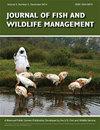Effect of herbivory on the nutritional value of six hardwood species for white-tailed deer in the Allegheny Forest
IF 0.9
4区 环境科学与生态学
Q4 BIODIVERSITY CONSERVATION
引用次数: 0
Abstract
Herbivores alter plant quantity and quality through direct tissue consumption and indirectly via the structural and chemical allocational strategies plants deploy in response to herbivory. Here we examine how browsing by white-tailed deer Odocoileus virginianus alters nutritional quality of six regenerating hardwood species (red maple Acer rubrum, black cherry Prunus serotina, birch Betula spp., pin cherry Prunus pennsylvanica, white ash Fraxinus americana, and American beech Fagus grandifolia). Using an established, large-scale experiment that manipulated deer access to plots using fencing, we tested whether browsing altered the nutritional quality and biomass as well as nutritional capacity to support deer of six hardwood species in an early successional hardwood forest of Pennsylvania, United States. Pin cherry was the most nutritious of the six species with greater dry matter digestibility and digestible protein and lesser neutral detergent fiber. Areas exposed to browsing had less browse biomass of stems and leaves yet greater digestible protein; an effect driven by digestible protein of pin cherry. We found no effect of browsing on neutral detergent fiber or dry matter digestibility. Although deer browsing reduced biomass of the six hardwood species, it did not alter the nutritional capacity to support lactating females in the summer. Our results confirm that browsing limits tree regeneration and available browse and provide conservative conclusions on how deer can alter their diet quality.食草动物对阿勒格尼森林中六种硬木物种对白尾鹿营养价值的影响
食草动物通过直接的组织消耗以及植物为应对食草而采取的结构和化学分配策略间接地改变植物的数量和质量。在这里,我们研究了白尾鹿 Odocoileus virginianus 如何改变六种再生硬木树种(红枫 Acer rubrum、黑樱桃 Prunus serotina、桦树 Betula spp.、针叶樱桃 Prunus pennsylvanica、白蜡 Fraxinus americana 和美洲山毛榉 Fagus grandifolia)的营养质量。我们利用已建立的大规模实验,使用栅栏控制鹿进入地块,测试了在美国宾夕法尼亚州的早期演替硬木森林中,啃食是否会改变六种硬木树种的营养质量和生物量,以及养活鹿的营养能力。在这六种硬木中,松樱桃的营养价值最高,干物质消化率和可消化蛋白质较高,而中性洗涤纤维较低。遭受采伐的地区茎叶的采伐生物量较少,但可消化蛋白质较高;这是樱桃可消化蛋白质的影响。我们发现,放牧对中性洗涤纤维或干物质消化率没有影响。虽然鹿的啃食减少了六种硬木的生物量,但并没有改变夏季支持哺乳雌性的营养能力。我们的研究结果证实,鹿的啃食限制了树木的再生和可获得的食物,并为鹿如何改变其食物质量提供了保守的结论。
本文章由计算机程序翻译,如有差异,请以英文原文为准。
求助全文
约1分钟内获得全文
求助全文
来源期刊

Journal of Fish and Wildlife Management
BIODIVERSITY CONSERVATION-ECOLOGY
CiteScore
1.60
自引率
0.00%
发文量
43
审稿时长
>12 weeks
期刊介绍:
Journal of Fish and Wildlife Management encourages submission of original, high quality, English-language scientific papers on the practical application and integration of science to conservation and management of native North American fish, wildlife, plants and their habitats in the following categories: Articles, Notes, Surveys and Issues and Perspectives. Papers that do not relate directly to native North American fish, wildlife plants or their habitats may be considered if they highlight species that are closely related to, or conservation issues that are germane to, those in North America.
 求助内容:
求助内容: 应助结果提醒方式:
应助结果提醒方式:


